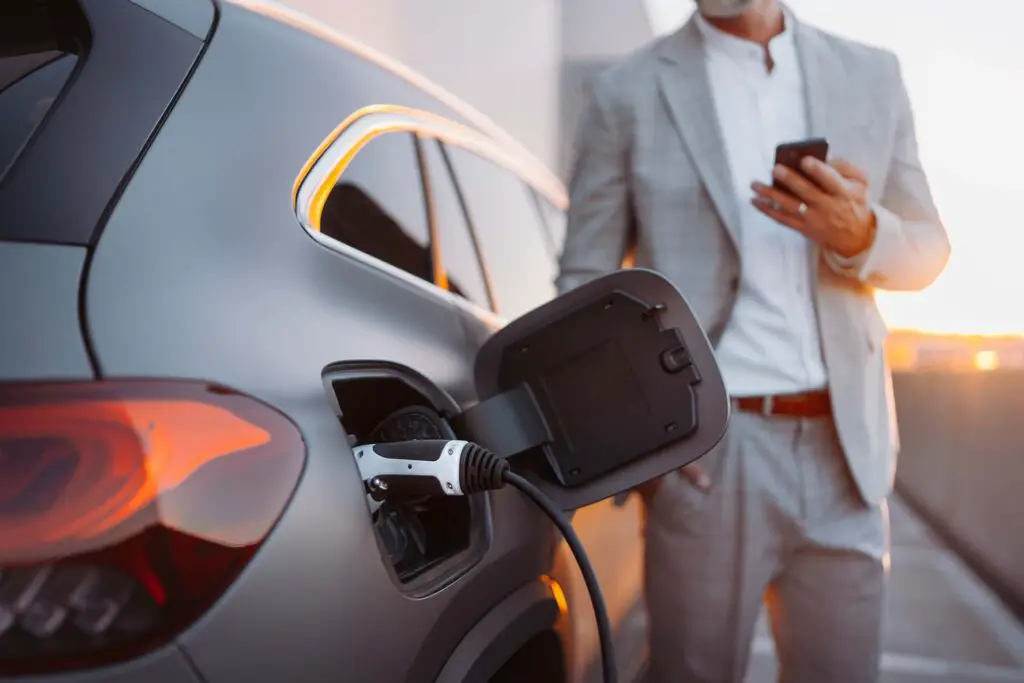Imagine cruising down the open road, the hum of your battery-powered four-wheeler, your only companion, and miles unfolding effortlessly beneath you. It might get you wondering – how many miles can an electric car go on one charge? Let’s crack the code of these eco-friendly cars and their respective ranges, journeying through the electrifying twists and turns of battery life.
How Many Miles Can an Electric Car Go?
The range depends on a variety of factors, including battery capacity, driving style, and environmental conditions. We’ve seen incredible progress, with some models now offering over 500 miles on a single charge. Thanks to innovations in battery technology and charging infrastructure, the future of the EV range seems boundless.

Let’s Start With the Basics of Electric Vehicle (EV) Range
When we talk about EVs, we’re really talking about a shift in the very essence of road-tripping, city commuting, and everything in between. These four-wheelers don’t use gas, and they don’t have an exhaust pipe either.
All of that raw power comes from batteries – big, sophisticated packs of energy, nestled within the vehicle, waiting to be unleashed with every press of the pedal. It’s a clean, green way to roll, replacing the old-school gas tank with innovative electric vehicle technology that’s all about efficient and sustainable transportation.
Gas vs. Hybrid vs. Electric Cars – How Do These Four-Wheelers Use Energy?
Gas cars are the old guard, relying on internal combustion engines where the fuel mixes with air, ignites, and vroom – you’re moving. A step up the ladder of green driving solutions, the hybrid vehicles are like the middle ground. These savvy machines carry a little bit of both worlds, combining a smaller internal combustion engine with an electric motor.
Then, there are the battery electric vehicles (BEVs), the stars of our auto show. No gas, no emissions – just a battery, an electric motor, and a whole new way to think about driving. They represent not just a different choice of fuel, but a new perspective on what it means to drive and own a vehicle. Every mile is a statement about the future, a step towards a cleaner, more sustainable way of life on the move.

What Are the Most Crucial Factors Affecting the EV Range?
There’s no simple answer to the question – how many miles can you go in an electric car? There’s no specific number – the answer is a story woven with various strands. Here are the crucial factors that ultimately determine how far you’ll travel on a single charge:
EV Battery Capacity
EV battery life is the most important aspect of this equation. The larger its capacity is, the further your prized ride can journey without a pit stop. Measured in kilowatt-hours (kWh), this figure is like the fuel tank in traditional four-wheelers, deciding how long you can explore on the famous US routes. But remember, with great capacity comes great weight and size. It’s a balance, a dance between power and practicality.
Electric Motor Efficiency
Now, let’s talk about the muscle behind the motion – the electric motor. Efficiency here is key. It’s not just about having energy – it’s about how well you use it. An efficient motor ensures that more of the battery’s stored power is translated into actual tire-turning movement. Lesser energy lost as heat means more miles covered, making motor efficiency a silent hero in the quest for range.
Vehicle Design
Last but certainly not least, let’s consider the stage on which this all plays out – the design of zero-emission vehicles. Aerodynamics and weight play starring roles here. A sleek, well-designed four-wheeler cuts through the air like a knife through butter, reducing drag and conserving precious energy.
Similarly, a lighter electric car needs less energy to move. Together, they shape the story of your journey, ensuring that every kWh of battery capacity is used most effectively, stretching each mile out just a little bit further.
An Inside Peek Into the Battery and Charging Electric Vehicles
As we’ve just discussed, beneath the sleek exterior of every EV lies its powerhouse – the battery. It’s literally the heart and soul of the four-wheeler, the very essence of mobility and range. There’s no going around the simple fact – its capacity, durability, and technology shape every mile traveled.
However, advanced EV batteries are not a one-size-fits-all kind of deal. Actually, there are many different types. Here’s a brief overview:
| Type | Pros | Cons |
| Lithium-Ion | High energy density, lighter weight, longer lifespan | Higher cost and the potential for thermal runaway |
| Nickel-Metal Hydride | Less expensive, more resistant to memory effect | Lower energy density, heavier than lithium-ion |
| Lead-Acid | Economical, well-understood technology | Lower energy density, shorter lifespan, heavier |
| Solid-State | Higher energy density, improved safety, longer lifespan | Currently expensive, technology is still under development |
It’s All About Efficient EV Charging and Maintaining Battery Health
The longevity and efficiency of your prized ride’s battery isn’t just about its inherent quality – it’s also about how you treat it. Proper charging and electric car maintenance can be the difference between a battery that fades and one that stays robust and reliable. Here are some helpful tips for nurturing the heart of your EV:
- Avoid letting the battery drain or charging it to 100% constantly, instead, aim for the sweet spot between 20% and 80%,
- Park in the shade or a garage when it’s hot, and consider pre-conditioning the battery in cold weather, as extreme temperatures can strain the battery,
- Smooth acceleration and deceleration conserve battery power and extend its life,
- Keep your EV’s software up to date to ensure optimal battery management and performance,
- Regular professional inspections can catch and address potential battery issues early on.

What Are the Real-World Factors That Impact Electric Car Mileage Limits?
Navigating the electric highways is not just about the numbers and the specs. It’s also about the journey, the style, and the rhythm of your drive. Push the pedal too hard, and you’ll watch the miles available tick down faster than the beat of a racing heart.
Speed is a thrill, but in the world of EVs, moderation is key. Quickstarts, sharp stops – they all nibble away at your battery’s endurance. Then there’s the stage on which this whole ordeal unfolds. A smooth, open highway is an invitation to glide effortlessly, while a crowded, stop-start cityscape is more of a challenging puzzle, each piece affecting your EV’s range. Uphill battles demand more from your battery, just as a heavy load can weigh down on your mileage dreams.
Don’t Forget About the Weather Too
But wait, there’s another character in this play – the weather. It’s not just a backdrop – it’s a hands-on participant, shaping your EV’s range with silent, invisible hands. Here are a few examples of how climate and terrain influence your drive:
- In the cold, batteries need to work harder, reducing your range,
- High temperatures can strain the battery’s cooling system, nibbling away at efficiency,
- Ascending takes extra effort, and your battery feels that pull, reducing range,
- When you’re going downhill, regenerative braking can actually give back energy, boosting your range,
- Like sailing, your EV feels the push and pull of the wind, impacting how far you can go.

Efficient Eco-Driving Practices for Maximizing Your Ride’s Range
To become the captain of an electric voyage, you need to master the art of the foot and the pedal. We’ve already shared some tips on charging and driving, but let’s uncover some additional hacks. One of the most important secrets to squeezing every mile from your electric car is smooth driving. Gentle accelerations, soft decelerations – it’s all about finding that sweet spot where energy flows seamlessly.
When it comes to charging, choose Level 2 chargers when you have time, and take advantage of off-peak rates with programmable timers. Keep your battery within the recommended state of charge, and you’ll be well on your way to cruising without the constant EV range anxiety. All in all, consider it a balancing act, a mix of mindful driving and smart charging, all aimed at making your precious ride go the extra mile.
The Evolution and the Future of the EV Range
The journey of electric vehicles has been nothing short of remarkable. From humble beginnings to the cutting-edge technology of today, they’ve certainly come a long way. Milestones like the introduction of lithium-ion batteries, which brought higher energy density and longer range, were game-changers. Tesla Model S set a new standard by offering over 300 miles on a single charge, redefining what’s possible.
Looking ahead, the future of EVs is electrifyingly bright. Automakers are investing heavily in research and development to push the limits even further. We’re seeing the emergence of solid-state batteries, which promise greater energy density and faster charging. Wireless charging technology is also on the horizon, making it even more convenient to power up your eco-friendly ride.
How Many Miles Can an Electric Car Go on a Full Charge? Here Are the Main Contenders
Curious about the top players in the range game? Here’s a peek at some long-range electric cars that are leading the pack:
- Lucid Air – 516 miles,
- Tesla Model S – 405 miles,
- Hyundai Ioniq 6 – 361 miles,
- Tesla Model 3 – 358 miles,
- Tesla Model X – 348 miles,
- Mercedes-EQ EQS450 – 340 miles,
- Tesla Model Y – 330 miles.

Plugging In, Rolling On – The Electrifying Current of Range Is Only Getting Bigger
This journey has been quite a ride. We’ve explored the factors that make every mile count, from battery capacity to eco-driving techniques. We’ve looked at the past, the present, and the tantalizing future of EVs, where the range knows no bounds. So, whether you’re cruising down the highway in a sleek Tesla Model S or embarking on a city adventure in a zippy Nissan Leaf, remember one thing – the road ahead is always full of surprises. Charge up, roll out, and let the journey begin!








